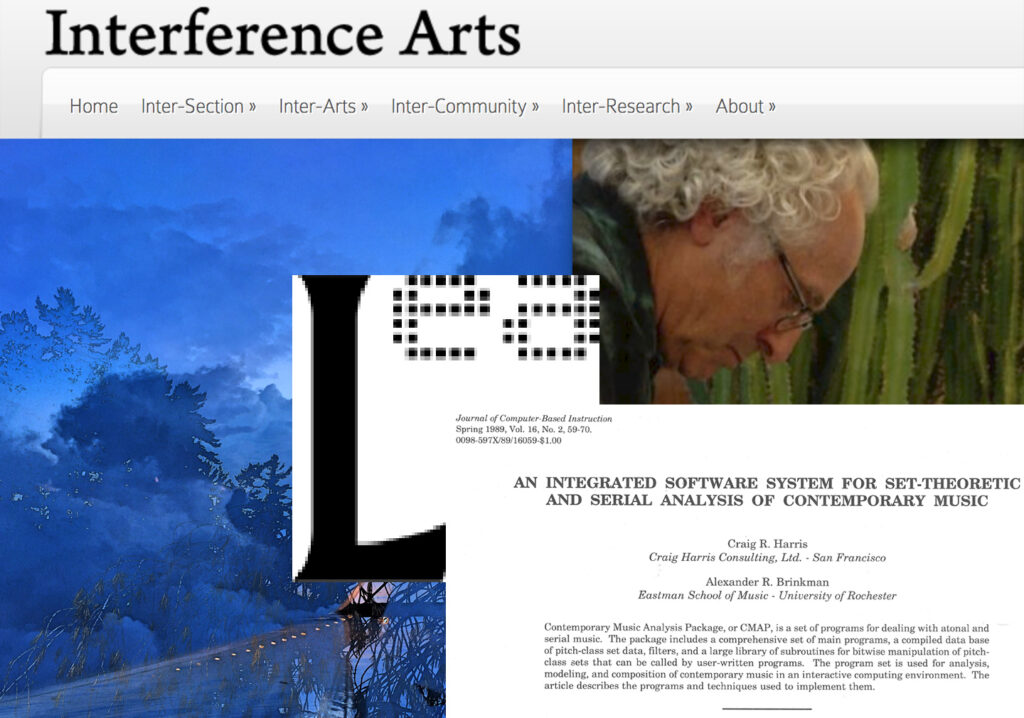Inter-Section
is a feature of the Interference Arts website that provides opportunities for visitors to get quick views into Artistic Director Craig Harris’ work and projects. Inter-Section presents highlights of specific projects with video and audio examples; contextualizes the work, illustrates connections between projects and initiatives; and provides pathways to navigate through the artistic, community development and research projects found on the Interference Arts website.
Thank you for visiting!

The February 2021 installment of Inter-Section features:
GONE – a multimedia performance & installation – Craig Harris and Candy Kuehn have completed new videos for the multimedia suite GONE, Harris’ keyboard suite about loss. The music has also been updated, and new piano recordings and the updated music score are now available. The new videos based on my keyboard suite GONE that visual artist Candy Kuehn and I have been developing are now finished, and can be viewed on a special page for this project. We have been working for two years on developing a multimedia presentation version of this work about loss, and we look forward to being able to present this version in a live environment when it becomes safe again to gather together.
Leonardo Electronic Almanac – Craig Harris became Executive Director of Leonardo, the International Society for the Arts, Science and Technology (Leonardo/ISAST) in 1990, and collaborated with American physicist, astronomer and ISAST Executive Editor/Chairman of the Board Roger Malina to facilitate enhanced international networking and collaborations in the emerging media arts field. During our work together we founded one of the Internet’s first web-based field journal, Leonardo Electronic Almanac, and this is the story behind the origin and development of that project.
Contemporary Music Analysis Package – The Contemporary Music Analysis Package (CMAP) is a set of computer programs for analysis, modeling and composition of atonal and serial music that Craig Harris created with music theorist Alexander Brinkman, completed in 1986. This is the story about the origin of this project.
The Interference Arts website has evolved in other ways as well. We updated the platform to better take advantage of current technological capabilities, and we significantly improved site performance. Also, more information is now available to learn about various artistic projects, arts-based community development work, and research activities.
GONE – a multimedia performance & installation

The loss of a loved one is accompanied by intense emotional upheaval, filled with complex feelings and memories. The sense of loss can be interpreted more broadly, to include loss experienced through major life changes, even loss resulting from what we experience in the world of the COVID pandemic – loss of our sense of normality, our sense of human connection, potentially loss of income or physical/emotional stability.
GONE can be experienced as a work for live music and/or multimedia performance/installation, recorded music, and video presentation. Video imagery for each movement was created in collaboration with visual artist Candy Kuehn. The multimedia performance version of the work is designed to incorporate video projection into an immersive environment comprised of multiple hanging scrims, with a multi-channel audio distribution design. The project is designed to establish a creative and safe context for the exploration of loss for individuals, and for small group discussion and sharing of experiences and feelings.
The movements in the suite include Passing, Release, Nostalgia, Loss, Emptiness, Gratitude, Regret, Longing, Guilt and Freedom. The suite also includes Earth and Sky, an electronic soundscape postlude that sometimes accompanies performances.
The keyboard suite was originally composed in 2017 for the Emotion Gallery, one scene in the dance theater production “Dancing on the Belly of the Beast,” created by the company Off Leash Area. The show explored adult orphanhood, and it was performed at the Ritz Theater in Northeast Minneapolis. Craig developed a solo piano version based on the music for a scene in that show entitled “Emotion Gallery,” and premiered GONE for a concert at Owatonna Art Center in September 2018, accompanied by Candy’s imagery.
Leonardo Electronic Almanac
In the early 1990s I had the opportunity to work with Roger Malina, the American physicist, astronomer, Executive Editor of Leonardo Publications by Leonardo, and Chairman of the Board of the Leonardo/The International Society of Arts, Sciences and Technology. In addition to his many accomplishments as a space scientist and astronomer, Roger was energetically exploring the realm where the arts, sciences and technology converge. I joined the organization as Executive director, and together we facilitated enhanced international networking and collaborations in the emerging media arts field. We collaborated to produce annual festivals and conferences, like the International Symposium on Electronic Art; we preserved the twenty-five year old arts, science and technology field journal Leonardo by establishing a long term comprehensive publishing collaboration with MIT Press; we launched significant new Leonardo Book Series; and we founded one of the Internet’s first web-based field journal, Leonardo Electronic Almanac.
Tremendous work was taking place at the intersection of art, science and technology in the early 1990s, yet much of it was taking place in isolation, disconnected from other relevant and related activities. There was a clear need to raise the profile of work on a global scale, and to identify ways to improve interdisciplinary communication and collaboration. The leadership at Leonardo/the International Society for the Arts, Sciences and Technology (ISAST) set on a path to play an important role in addressing these issues for its community. One critical component responding to the challenge was to create a high quality online journal that could respond more quickly to the increasing speed of development in the field than was possible through the hard copy journal Leonardo, which had an 18-month to 2-year article and publication development cycle. Another goal was to raise the profile of the intense, diverse work taking place around the world, and to facilitate communication and collaboration taking advantage of the quickly evolving Internet.
We launched Leonardo Electronic Almanac (LEA) in 1993, with a long-term publishing agreement with MIT Press. LEA has evolved over the years, and is still available through MIT Press.
Contemporary Music Analysis Package
The Contemporary Music Analysis Package (CMAP) is a set of computer programs for analysis, modeling and composition of atonal and serial music I created with music theorist Alexander Brinkman, completed in 1986. The package includes a set of programs designed to be used in an interactive computer environment such as UNIX or MS-DOS. This article describes the origin of the development of CMAP.
The area of study in music that encompasses set theory was spear-headed by several renowned theorists, including John Rahn, Michael Forte, Robert Morris, Daniel Starr and others, and was emerging as a crucial direction in music theory in the late 1970s and 1980s. I quickly discovered that work in this area was an extremely time consuming process – exploring pitch class similarities and differences; investigating the characteristics of pitch class sets in various inversion and complement forms, and, when it came to applications in serial music, probing all of these characteristics in the realm of ordered pitch classes (and their inversions and retrograde forms). It was clear that the available tools for working in this area were negatively impacting development of the field. Theorists were limited in their ability to cover large bodies of the music repertoire; and composers were stifled in their ability to creatively explore diverse musical materials.
I collaborated with music theorist Aleck Brinkman to create the Contemporary Music Analysis Package (CMAP), a rich set of tools and a flexible processing environment to be used for set theoretic and serial analysis and composition of contemporary music. CMAP was a combination of standalone tools to analyze pitch material in various ways, and it functioned in a UNIX operating system that made it possible to sequence and filter data and operations to greatly reduce the amount of time required to work in this way. The package made it possible to cover a significantly broader amount of material, and to probe deeper into aspects of the information than previously possible.
In the late 1980s CMAP was in use at approximately 84 institutions around the world. Peter Castine developed a Macintosh version of the system as well. At the time of writing this article CMAP is no longer available for distribution.
I reached out to reconnect with Aleck Brinkman as I was writing this, and was sad to learn that he passed away in April 2019. Aleck was a wonderful, thoughtful human, an inventive music theorist, and played a mean jazz bass.

